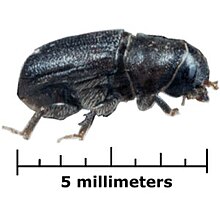- The unrelated sawyer beetles (Monochamus) and some other wood-boring beetle taxa (especially Cucujoidea) are sometimes called "bark beetles" too.
| Bark beetles | ||||||||||||
|---|---|---|---|---|---|---|---|---|---|---|---|---|
 Mountain pine beetle, Dendroctonus ponderosae | ||||||||||||
| Scientific classification | ||||||||||||
| ||||||||||||
| Tribes | ||||||||||||
| Cortylini |
A bark beetle is one of approximately 220 genera with 6,000 species of beetles in the subfamily Scolytinae. Traditionally this was considered a distinct family Scolytidae, but nowadays it is understood that bark beetles are in fact very specialized members of the "true weevil" family (Curculionidae). Well-known species are members of the type genus Scolytus - namely the European elm bark beetle S. multistriatus and the large elm bark beetle S. scolytus, which like the American elm bark beetle Hylurgopinus rufipes transmit Dutch elm disease fungi (Ophiostoma). Another well-known species of Europe is the Ips typographus.
Ecology
Bark beetles are so-named because the best known species reproduce in the inner bark (living and dead phloem tissues) of trees. Some species, such as the mountain pine beetle (Dendroctonus ponderosae), attack and kill live trees. Most, however, live in dead, weakened, or dying hosts. Bark beetles are ecologically and economically significant. Even outbreak species can help to renew the forest by killing old trees. Other species aid in the decomposition of dead wood. However, several outbreak-prone species are known as notorious pests.
Bark beetles often attack trees that are already weakened by disease, drought, smog, conspecific beetles or physical damage. Healthy trees may put up defenses by producing resin or latex, which may contain a number of insecticidal and fungicidal compounds that can kill or injure attacking insects, or simply immobilize and suffocate them with the sticky fluid. Under outbreak conditions, the sheer number of beetles can however overwhelm the tree's defences, and the results can be disastrous for the lumber industry.

In some places, like Šumava National Park in the Czech Republic's Bohemian forest, problems with bark beetles have become a heated issue with a political dimension. On one side, some experts (usually with a background in environmental sciences) demanded that nature be left alone and that natural processes be allowed to take their course, even if it meant that the bark beetle would destroy most of the forest. On the other side, other experts (usually with a background in forest management) demanded intervention. During the 1990s and 1980s, the Šumava park management mostly favoured intervention. Many outside groups became involved in the dispute, such as the lumber industry (which supported intervention because of possible profit to be made), or some local politicians, afraid that tourists would turn back from a forest decayed after a beetle invasion. The anti-intervention side got support from entomologists from the Czech Academy of Sciences and from several environmental organizations, such as Friends of the Earth. At the height of the dispute, there were cases where activists literally defended the trees with their bodies, tying themselves to the trunks, and the dispute was widely covered in the main Czech daily newspapers and on TV news.[1]
Some bark beetles form a symbiotic relationship with certain Ophiostomatales fungi, and are named "ambrosia beetles" after these "ambrosia fungi". The ambrosia beetles (such as Trypodendron) feed on fungal "gardens" and are one of only three insect groups known to farm fungi. The other two groups are ants and termites, neither of which is particularly closely related to beetles. Courtesy of the fungus, ambrosia bark beetles are able to indirectly feed from many more species of trees than their evolutionary relatives that do not feed on fungi, by having the fungi do the work of overcoming the plant's chemical defenses. The beetles carry the fungal spores in special structures called mycangia, and inoculate the trees as they attack them.
Like many other insects, Scolytinae will emit pheromones to attract conspecifics which are thus drawn to trees already beset with bark beetles. This can result in heavy infestation and eventually death of the tree. Many are also attracted to ethanol, one of the by-products of decaying trees.
Gallery
| |






0 comments:
Post a Comment